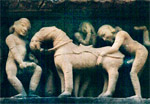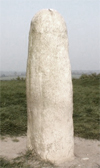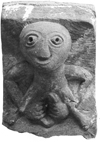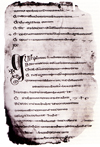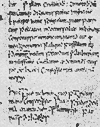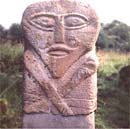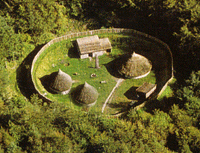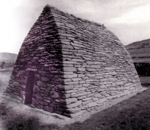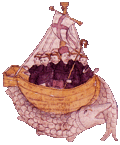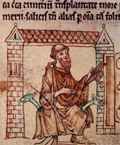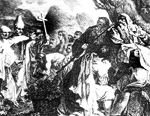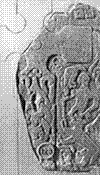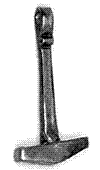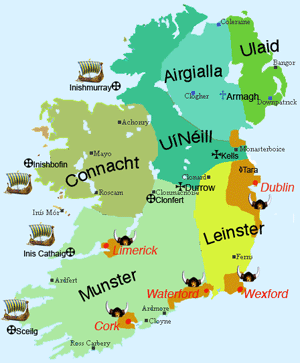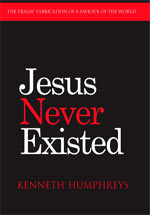
Was It Good for You?
Gratuitous horse-sex
"As late as the end of the 12th century Geraldus Cambrensis reports that the kings of Clan Connaill continue to be inaugurated in the high style of their ancestors – by public copulation with a white mare."
– Thomas Cahill, How the Irish Saved Civilization, p135.
The mare, it seems, symbolized the land, to whom the high king was 'married.' In some reports the horse was ritually slaughtered and reduced to a broth. The king climbed into the cauldron and symbolically ingested his 'bride.'
Tara – Here be the High Kings
Tara – not exactly a metropolis.
Tribal gathering centre until the 11th century – though apparently 'cursed into ruin' by 6th century St Ruadhan.
Penis Worship
Lia Fail penis-stone, Tara
"There it was placed upon the sacred hill of Tara, and called Lia-Fail, the 'fatal' stone, or 'stone of destiny ..." ('Chronicles of Eri')
Apparently the stone screamed when touched by the true king. Well it would, wouldn't it.
Penis Sacrifice
The phallic Turoe Stone, Galway, originally stood on the site of an Iron Age ring-fort and is thought to have been an essential element in ritualistic human sacrifice.
Vulva Worship
Delightfully rude Sheela-na-gig ('Sheelagh of the Breasts').
Such symbols of protective 'female power' are found all over Ireland, notably on churches!
Keeping It All in the Family
"Bigamy was neither illegal nor uncommon; concubinage was regular and the offspring were not necessarily excluded."
Fry (A History of Ireland, p31)
The 2-Ditch Family
"Raths or cashels of kings were generally identified by their being surrounded by two complexes of banks or ditches, as stipulated in brehon law."
– Fry (A History of Ireland, p30)
Makeovers for the Lord
Druid stone captured for Christ (County Kerry)

Croagh Patrick, Co. Mayo
Pagan cult centre of Cruachan Aigli, used for the fertility festival of Lughnasa. Lugh was the Celtic sun God.
The mountain was given a Christian gloss with silly stories of St Patrick – thus rendering it as "the Sinai of Ireland."
If you really want to cleanse your soul you climb the mountain on your knees.
Ogham – Don't try this at home
Homer's Iliad would be a tad challenging in this early Irish script.
Christ Magic
Worth 3000 lives? A page from the 'Cathach'. Enclosed in a shrine in the 11th century, it was carried into battle as a talisman.
Patrick: Confessions of a Cabin Boy
St Patrick's 'Confessio' from the 9th century 'Book of Armagh.'
"And so, on that day, I refused to suck the breasts of these men from fear of God, but nevertheless I had hopes that they would come to faith in Jesus Christ, because they were barbarians. And for this I continued with them, and forthwith we put to sea."
The "Confessio" of Saint Patrick (18)
Helios (1st century Roman coin)
Patrick: Sun Worshipper
"There fell on top of me as it were, a huge rock, and not one of my members had any force. But from whence did it come to me, ignorant in the spirit, to call upon 'Helias'?
And meanwhile I saw the sun rising in the sky, and while I was crying out 'Helias, Helias' with all my might, lo, the brilliance of that sun fell upon me and immediately shook me free of all the weight."
The "Confessio" of Saint Patrick (18)
Celtic sun-god (2nd century, Haute-Marne, France)
"We, on the other hand, shall not die, who believe in and worship the true sun, Christ."
The "Confessio" of Saint Patrick (60)
Celtic deity in Christian graveyard (Boa Island, 5th-7th century)
Christ Magic
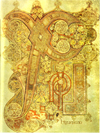
8th century Book of Kells.
10 years in the making. The 'XP' or chi-rho fills a whole page.
Erudition and wisdom – or just a pretty picture?
"To Celtic taste, a plain colour or a plain surface seemed almost abhorrent." (Sitwell, p7)
7th century Book of Durrow
"One 17th century traveller reports staring in horror as the priceless Book of Durrow was dipped in water by farmers who used it, as needed, to flavor a tonic for sick cows."
– T. Cahill, How the Irish Saved Civilization, p212.
10th century hideaway from the Vikings – a tall tower. (Clonmacnoise monastery)
Clonmacnoise, one of Ireland's earliest monasteries, dating from 545 AD – a century later than 'St Patrick'.
There was never a single large church here, but rather a collection of wooden huts, frequently burnt to the ground – at least 3 times in the 8th century alone, during a 'war' with the rival monastery at Durrow.
The earliest stone church dates from the 10th century. The graveyard from the 12th century.
Wonderful Murderers!
"What is it but a unique and wonderful act of divine generosity when the Almighty God treats murderers, thieves, adulterers, perjurers, and criminals of all kinds as though they were men of righteousness and worthy to be called to his service.
Do not hesitate ... O mighty soldier, O man of war, you now have a cause for which you can fight without endangering your soul ... "
– St Bernard of Clairvaux summons the dregs to plunder for Christ (Letter 363)
The conversion of northern Europe to Christianity was a bloody and brutal business, continued in the face of fierce resistance by the heathen. In Ireland, there was no obvious 'Charlemagne' butchering the natives into submission, though the process was not without bloodshed.
The Christianizing of Ireland On the western fringe of Europe, Ireland's iron age tribal society – migratory pastoralist, living by cattle herding, rustling and raiding, and with limited agriculture – had continued largely unchanged either by the rise or the collapse of the western empire. In the 1st century the Romans had mapped the island's coastline and traders had entered Irish waters, even establishing a trading post at Stonyford on the Nore. Agricola had considered an invasion during his campaign in Britain, deploying a single legion to subdue the island, but it was not to be. Hibernia remained a neighbour to a Romanized Britain for 400 years, but trade and other contacts were never sufficient to change the nature of Ireland and urbanisation never took hold. No roads existed and coinage was unknown. Without the civilising presence of Rome, nothing drew the Irish tribes into recognisable towns, or even villages. The basic unit of habitation in this fragmented warrior society was the ringfort (sometimes several of them in close proximity) – either a stone-walled 'cashel' or an earthen banked 'rath.' Within the ringfort stood wretchedly flimsy huts or partially sunken 'souterrains'. Of an estimated 50,000 such 'forts' average occupancy was an extended family ('Derbfine' or 'sure kin') of twenty. 'Marriage' had a fairly loose meaning. A clan's chosen chieftain was held to embody the tribe's finest qualities and it was a privilege for a woman to bear his offspring and strengthen clan identity.
Wild Roman writers recorded the tribesmen of Ireland as being even fiercer than the Britons. Human heads were taken as trophies and Strabo and Jerome both comment on Irish cannibalism. Inter-tribal warfare was endemic though the clans fought as a horde, in complete disarray. Their weaponry was limited, spears, slings and axes – their most prized possessions – and they wore no armour. If the tribesmen rode to battle on horse it was without benefit of stirrup or bridle, and they dismounted to fight. One consequence of Rome's decision not to invade was that the Christianizing of Ireland, no less insidious than elsewhere in Europe, was a particularly protracted process. In the barbarous conditions of the island the eradication of pre-Christian religion took many centuries. In the 4th century, as Rome's hold on Britain weakened, the Gaels began slave-raiding along the west coast of Britain.
A Heathen Isle Ireland had its 'kings' – perhaps as many as 150 – but 'king' implied nothing of 'court and palace' but rather, a parochial warrior chieftain, a dominant barbarian enjoying the luxury of two ditches about his desperately primitive corral and holding as personal slaves any hostages the tribe might have come by. Tribal members paid tribute to the king in the form of cattle, sheep, and grain and served as warriors in time of war. The king was guided by his 'brehon' (judge) and by peripatetic witch-doctors – the Druids, a revered priesthood, holding power over life and death, and, according to Caesar, making human sacrifices. Poets and bards (the filid) committed to memory tribal exploits and were held in high regard. When the kingship system intermittently threw up a 'High King' the tribes gathered, hostages were taken from the submitting clans, and the warrior overlord had sex with a horse (see side quote). After perhaps a week of ceremony, drunkenness and 'judgments' the tribes dispersed to their forts, watery bogside 'crannogs' and subterranean hovels. The Conversion Myth:
The Reality: Despite the poetic notion of a golden age of 'saints and scholars' between the 6th and 9th centuries (and a handful of 'illuminated' gospels as if to prove the point) the reality is far more sober: early attempts to Christianize the barbarous savages of Ireland were ephemeral, compromised, and highly localised. A primitive Christianity reached the British Isles in the late 3rd/ early 4th centuries, where it competed with both established Roman religions and native Celtic cults. It must have gained a boost from the elevation of Constantine (three bishops from Britain are known to have attended the Emperor's Synod of Arles in 314, which imposed Constantine's ruling against the Donatists), though archaeological evidence suggests Mithraism retained a far bigger following in Britain than Christianity. This British (or Celtic) 'Christianity' pre-dated any agreed canon of sacred texts, sacraments, liturgical year or organisation. At Ariminum in 359 British bishops are known to have supported Arianism. Early Romano-British Christians, in common with the brethren in other parts of the empire, were evolving their own version of 'divine truth' and had no natural subordination to a bishop in Rome.
The 'free' Church of the British Isles In the early 5th century, an individualistic form of Christianity emerged in Roman Britain under the guidance of Pelagius (354-418), which stressed free will ('De libero arbitrio') and the ability of the individual to find God through personal faith (sola-fides doctrine centuries before Luther!). JC's redemption was held to be by instruction (doctrina) and example (exemplum) – salvation without the Church – not an approach which found favour with the ambitious pontiffs on the Tiber! In contrast, in north Africa, Augustine (locked in a bitter conflict with the tenaciously 'independent' Donatists) was promoting the novel doctrine of 'original sin' and the 'tainting' of man’s nature by the behaviour of Adam. Only through the sacraments of 'Holy Mother Church' could a supplicant receive 'Divine Grace,' a dogma the bishops of Rome found highly acceptable. Pelagius vigorously rejected Augustine's notions and when he reached Rome, his severe asceticism was horrified by the obvious grandeur of the Church hierarchy, and of the papacy in particular. His 'liberal' Christianity, upheld in Jerusalem in 415, was condemned repeatedly in Rome and at other Catholic synods (the Councils of Carthage 416 and 418 and as late as 529 at the Synod of Orange.) Urged on by Pope Boniface and the Empress Galla Placidia, the feeble Emperor Honorius (395-423) expelled Pelagians from Italy (he had little authority elsewhere) and issued an edict requiring all bishops to sign Pope Zosimus's 'Tractoria' condemning Pelagius's 'heresy.' Despite the censure, in the 5th and 6th centuries Pelagianism spread far across the Roman world and found natural allies with other factions locked in conflict with the Bishop of Rome – for example, the Nestorians (for a time, the 'national' Christian church of Persia). Across the Irish Sea, the blending of Christianity into native culture would be even more pronounced.
Island of the Druids During the 4th and 5th centuries, a tiny handful of British Christians – captives, traders, repatriating auxiliary troopers, and adventurers – made passage to the non-Romanised island further west. They took their idiosyncratic understanding of the faith with them.
He claimed "thousands" of converts, yet also admitted "daily expecting to be murdered or betrayed or reduced to slavery." His achievement, such as it was, was confined to Airgialla (close by the ancient tribal centre of Emuin Machae). In later centuries, as the bishopric of Armagh sought to establish a universal authority, Patrick's memory was to be finessed into the cult still with us today. He is credited with the unlikely act of changing his friends into deer so that they could escape their enemies and the no less unlikely act of founding the town of Armagh in 444 on a ridge where he brought back to life the local chief (and his horse!) For those, like Patrick, not born in Ireland the re-settlement could not have been easy – Hibernia's primitive barbarism knew nothing of civilization.
Christo-Druids To survive in this hostile environment the early Christians assumed the mantle of the Druids, rival magicians and soothsayers but also possible converts. For the Celts, religion and 'prophecy' were nature-based, conducted in sacred groves and streams, without need of dedicated buildings. Water deities and 'healing waters' were commonplace. The word 'Druid' itself is derived from a word meaning 'oak tree'. The earliest Irish Christians lived and worshipped in caves and forest glades, just like the rival Druidic priests. They wore the same white woollen robes. Sacred pools and springs were transformed into holy wells and rededicated to obscure Christian mystics. Local kings were often hostile to the newcomers but a modicum of learning, and a handful of artifacts, marked them out as 'gurus,' 'magicians,' a new type of Druid – men to be respected and feared.
Where that failed, Christ-magic – a gem-encrusted reliquary, for example, or trance-induced prophecy, ritual chanting or the 'power of words' – could engender fear, respect, acceptance and land. At first, in desperately primitive shelters, later in circular enclosures at favourable water sources, the evangelizers constructed simple huts and a stone building for prayer – a far-cry from a Romano-British town but an advance for Ireland. Apart from Patricus, we know that a Secundinus moved into Meath (Dunshaughlin), Auxillius into north Leinster (Killashee), and Benignus into Armagh. Their 'monasteries' echoed the basic unit of habitation in the warrior society of Hibernia: the ringfort, and perhaps also the monkish communities pioneered in the even more severe Egyptian desert. Each monastery (or group of kindred monasteries, a paruchia) maintained its independence and followed its own 'rule' – or lack of it. Rival 'soldiers of Christ' competed for power and influence and not infrequently their 'houses' waged war on each other. At times they sided with the local tribe in a blood-feud with a neighbouring clan. Thus, for example, the 6th century Colum Cille (aka St Columba) lost out and was exiled to Iona by King Diarmait after a battle in which a psalter (thereafter known as the "Cathach" or Warrior Psalter) was the spoils of war. 3000 had died. The excommunicated evangelizer left Ireland behind for better prospects in Scotland (he spent thirty-four years on a rock – saving civilization.) Left to its own devices the Irish Christianity that eventually took hold compromised heavily with the native tradition and moved by stealth. Irish Christianity parted company with 'Roman' ideas of bishops ruling geographic territories, a uniform liturgy and Roman sacraments – and settled for land grants and close integration with the tribal structure. Marriage and concubinage were common among the monks. The monasteries attracted the shanties of servers and vassals and grew in size. Collective property at first, they rapidly became inherited personal property. Authority rested in the hands of an increasingly powerful Abbot, appointed from a single family. The numerous bishops performed a subordinate priestly role. Druidic legends and Celtic gods found their way into a very 'Irish' form of Christianity in which 'saints' were everywhere, working miracles, uttering prophecies and enjoying divine visions ("Colman. There are about 300 saints of this name mentioned in Irish martyrologies." – Oxford Dictionary of Saints). Even women might take a leading role – a Christian version of 'Druidic priestesses' unthinkable in Catholicism.
Viking Dawn The Vikings – rarely credited with the role of civilizer – undisputedly established the first towns in Ireland in the 9th century.
Having successfully plundered the west coast, in the early 10th century the Vikings established permanent settlements in the south and east – at Waterford, Wexford, Wicklow, Limerick, Cork and Carlingford. A Viking settlement on the River Liffey was Dubh Linn. To feed themselves the newcomers introduced farming techniques hitherto unknown in a land still largely dense forest and bog. They traded across the Irish Sea, in the process familiarising the natives with keel-based boats and coinage. But the Norsemen were cut off from each other save by sea. Survival often meant alliance with the local clan. They married local girls, took to speaking Gaelic, and went 'local.' Militarily they were a spent force after a crushing defeat by a (rare) alliance of native tribes in the 10th century. The Viking settlers were not hostile to Christianity as such but were wary of a 'state-sponsored' or imposed religion. Parallels between Viking religion and Christianity abound. In Norse mythology their principal god Odin sacrificed himself (to himself!) by hanging for nine nights on the World Tree (Yggdrasil) in order to learn the mysteries of the runes. The spirit realm of Asgard – and within it, Valhalla – were a 'heaven' for fallen heroes. The world would end with the final battle of Ragnarok between gods and giants. With changes in their vernacular, these 'Ostmen' (foreigners) adopted a freely interpreted Irish Christianity, blended with their traditional paganism.
The island of Hibernia (or Scotia), outside of a handful of scattered, secularised and rival monasteries, remained essentially pagan until at least the 12th century, when a Roman Christianity was brutally imposed by French Catholics, otherwise known as "Anglo-Normans."
Norman Catholicism Takes Command In 1139 the Bishop of Armagh, Máel Sechnaill (aka 'St Malachy'), appealled to the head of Roman Catholicism's prevailing avant guard, Bernard Sorrel, head of the Cistercian Order, based at Clairvaux in France. The fanatical St Bernard chalks up among his achievements advocacy of the crusading orders, particularly the Knights of the Temple of Solomon – the Templars (founded in 1120); the triumph of his nominee Innocent II in an 8-year fight with the 'anti-pope' Anacletus; and inspiration for the Second Crusade of 1147. The meddlesome politico-bishop saw an opportunity in Malachy's tale of woe. Malachy complained to the abbot that Irish monasteries had fallen into the hands of secular princes and families, who billeted troops in them; that the monks themselves kept concubines and lived with their families; and that the Irish populace practiced civil marriage, made and dissolved at will without regard to the church. Lamented Malachy:
Bernard responded with a detachment of Cistercian monks who set up an abbey at Mellifort (nr Drogheda) in 1142. Fanning out across the countryside a clutch of daughter houses followed and other existing houses brought into the new order. But Malachy's 'distressing' report had not stopped with Bernard but had gone on to the Pope, who was at the same time receiving reports from Theobald, Archbishop of Canterbury. Theobald raised his own concerns about the free-wheeling Irish Church – its operatives were active in Britain and threatening his own power-base. Malachy himself was given legatine powers by Innocent II to impose Roman Obedience (a sartorial flourish was the introduction of the Roman-style bishop's pallium) – but it was not enough. A papal legate, Cardinal John Paparo, put in a presence at the Synod of Kells in 1152 and reported back to Rome, where a far more drastic solution to the Irish question was conceived by a new and energetic incumbent on the papal throne. In
1155 Pope Hadrian IV – an
Englishman trained as a French cleric – issued the notorious
bull Laudabiliter urging
England's Henry II to conquer Ireland:
Wary that his Norman knights might carve out an independent kingdom, Henry II took over and completed the conquest of Ireland. A Synod of Cashel followed in 1172. Christianus, papal legate and bishop of Lismore, presided. It marked the end of an independent Celtic Church. The native liturgies and practices were suppressed, the Roman Obedience imposed. By a combination of castle and church, feudalism was introduced into Ireland and ancient liberties extinguished. Anglo-French knights (de Clares, de Barrys, de Montmorencys, le Groses, et al) grabbed vast estates. Roman Catholicism sank in its insidious roots and the 'take' for St. Peter and the Pope was an annual pension of 'one penny from each house'. In time, like other invaders before them, the Norman Catholics would be absorbed into Ireland – but a thousand years of religious strife lay ahead.
Sources:
Copyright © 2004
by Kenneth Humphreys.
|
||||||||||||||||||||||||||||||||||||||||||||||||||||||||||||||||||||||||||||||||||||||||||||||||||||
